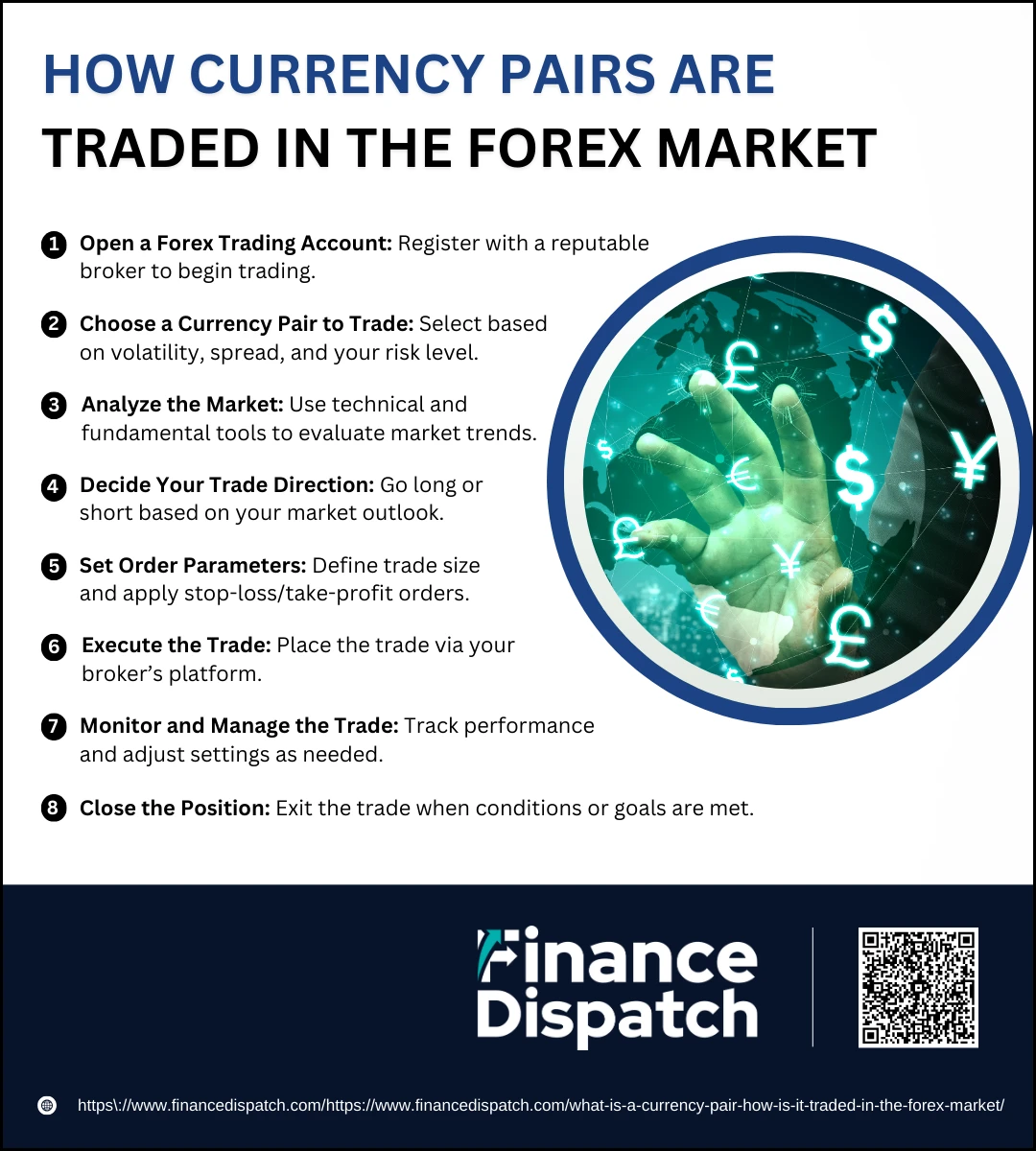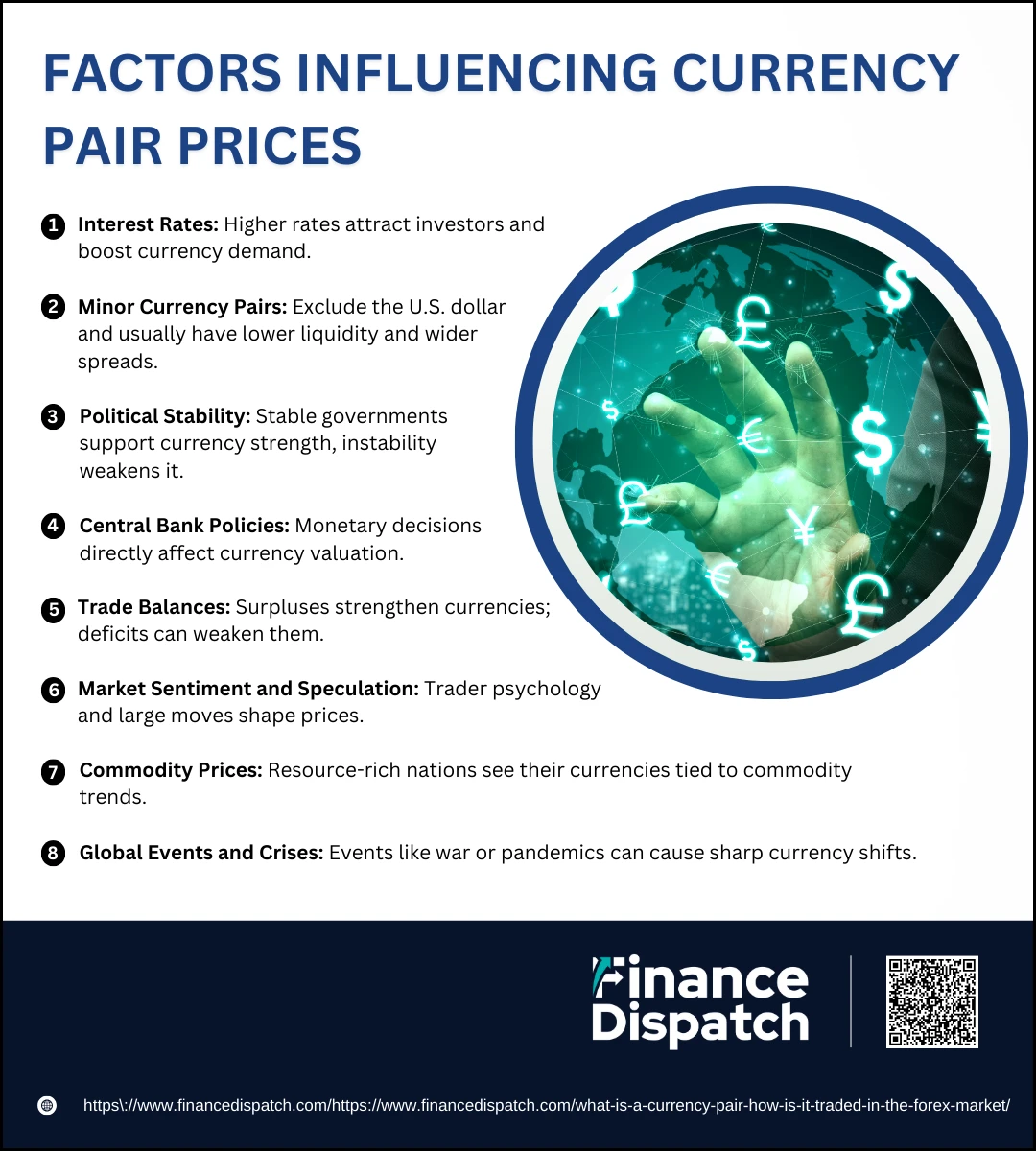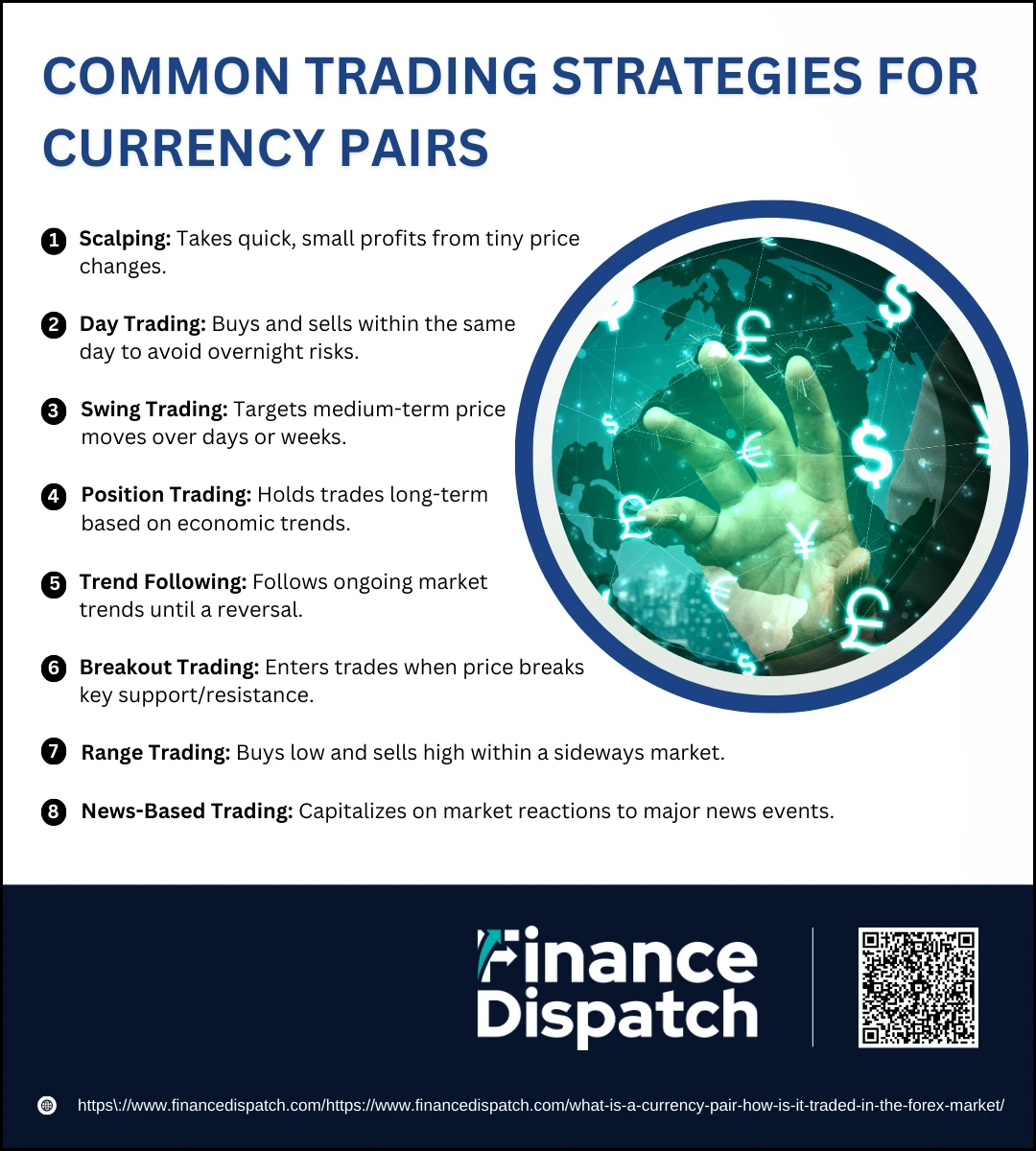In the world of foreign exchange (Forex) trading, a currency pair is the fundamental building block. It represents the value of one currency relative to another, allowing traders to speculate on exchange rate fluctuations between the two. Every Forex transaction involves buying one currency and simultaneously selling another, always quoted as a pair—such as EUR/USD or USD/JPY. This dual structure makes Forex trading unique compared to other financial markets. By understanding how currency pairs work, traders can make informed decisions, analyze global economic movements, and potentially profit from shifts in international currency values.
What is a Currency Pair?
A currency pair is a quotation of two different currencies in the foreign exchange (Forex) market, where the value of one currency is quoted against the value of another. The first currency in the pair is called the base currency, and the second is known as the quote currency. The pair shows how much of the quote currency is needed to purchase one unit of the base currency. For example, in the pair EUR/USD = 1.10, the euro (EUR) is the base currency, and the U.S. dollar (USD) is the quote currency—meaning 1 euro is equal to 1.10 U.S. dollars. All Forex trades involve the simultaneous buying of one currency and selling of another, making the currency pair a key unit in every transaction.
Major Components of a Currency Pair
To understand how currency trading works, it’s essential to break down the two key components of a currency pair: the base currency and the quote currency. These elements define the structure of any Forex trade. Additionally, understanding how exchange rates, bid/ask prices, and PIPs function within a pair helps traders interpret market prices accurately and make informed decisions.
| Component | Description |
| Base Currency | The first currency in the pair; represents the currency being bought. |
| Quote Currency | The second currency in the pair; represents the currency being sold. |
| Exchange Rate | Indicates how much of the quote currency is needed to buy one base currency. |
| Bid Price | The price at which the broker buys the base currency from the trader. |
| Ask Price | The price at which the broker sells the base currency to the trader. |
| Spread | The difference between the bid and ask price; represents transaction cost. |
| PIP | “Percentage in Point” – the smallest price movement in the exchange rate. |
 Types of Currency Pairs
Types of Currency Pairs
In the Forex market, currencies are always traded in pairs, but not all pairs behave the same way. They are categorized into three main types: major, minor, and exotic currency pairs. This classification is based on their global trading volume, liquidity, and the economic stability of the countries involved. Understanding these types allows traders to tailor their strategies based on risk tolerance, volatility, and market activity.
1. Major Currency Pairs
These pairs feature the U.S. dollar (USD) on one side and one of the other most traded global currencies, such as the euro, Japanese yen, or British pound. Major pairs are the most liquid, meaning they are traded in high volumes and have tighter spreads. They tend to have more predictable price movements and are ideal for both beginners and professional traders.
Examples: EUR/USD, USD/JPY, GBP/USD, USD/CHF.
2. Minor Currency Pairs
Also called cross-currency pairs, minors include two major currencies but exclude the U.S. dollar. They usually have lower liquidity and wider spreads than majors but still offer solid trading opportunities. These pairs are often used to speculate on regional economic strength or differences in interest rates.
Examples: EUR/GBP, GBP/JPY, AUD/NZD.
3. Exotic Currency Pairs
Exotic pairs consist of one major currency and one currency from a developing or emerging market economy. These pairs are known for their low liquidity, wider spreads, and higher volatility, which can lead to greater risk but also larger profit potential. They are typically suited for experienced traders who can handle rapid market changes.
Examples: USD/TRY (U.S. dollar/Turkish lira), EUR/THB (euro/Thai baht), USD/ZAR (U.S. dollar/South African rand).
 How Currency Pairs are Traded in the Forex Market
How Currency Pairs are Traded in the Forex Market
Trading currency pairs in the Forex market involves the exchange of one currency for another with the goal of profiting from fluctuations in exchange rates. Every trade is based on the relative value between two currencies—when you buy one, you are simultaneously selling the other. Forex trading operates 24 hours a day, five days a week, across global financial centers, making it the most liquid and active market in the world. To trade effectively, traders need to understand market behavior, use analytical tools, and apply sound risk management strategies.
1. Open a Forex Trading Account
To begin trading, you must register with a licensed Forex broker. Choose a platform that offers low spreads, fast execution, leverage options, and strong customer support. Most brokers offer demo accounts, which are great for practicing without risking real money.
2. Choose a Currency Pair to Trade
Currency pairs vary in terms of liquidity, volatility, and trading costs. Major pairs like EUR/USD or USD/JPY are commonly recommended for beginners due to their high trading volume and tighter spreads. Advanced traders may explore minor or exotic pairs for higher risk-reward opportunities.
3. Analyze the Market
Use technical analysis (charts, trendlines, indicators) to study past price behavior and fundamental analysis (news, interest rates, economic indicators) to anticipate future market movements. Combining both gives a more complete view of potential price action.
4. Decide Your Trade Direction
If your analysis suggests the base currency will appreciate, you open a long (buy) position. If you expect the base currency to depreciate, you go short (sell). The goal is to profit from the movement in the currency pair’s exchange rate.
5. Set Order Parameters
Define your lot size (amount of currency to trade), and use tools like stop-loss orders (to limit losses) and take-profit orders (to secure gains). This is a critical part of risk management and helps protect your capital in volatile conditions.
6. Execute the Trade
Place your trade through the broker’s trading platform. The platform will confirm the trade execution at the current market price or a price you specify, depending on the order type (market, limit, or stop order).
7. Monitor and Manage the Trade
Keep an eye on your open positions, monitor news updates, and assess market reactions. You may choose to adjust your stop-loss or take-profit levels based on market volatility or new insights.
8. Close the Position
Once your profit target is reached or if the market moves against you, close the trade manually or automatically via your set parameters. Your profit or loss is then realized and reflected in your account balance.
 Factors Influencing Currency Pair Prices
Factors Influencing Currency Pair Prices
The price of a currency pair in the Forex market is not random—it is shaped by a complex interplay of global economic, political, and market-specific factors. Since each currency reflects the health and stability of its issuing country’s economy, any shifts in policy, performance, or global sentiment can directly influence its value relative to others. Traders who understand these drivers can anticipate trends more accurately, reduce risks, and enhance their decision-making. Let’s explore the key factors that influence currency pair prices in more detail:
1. Interest Rates
Interest rates set by central banks are among the most influential factors in currency pricing. A higher interest rate in one country relative to another attracts foreign investors seeking better returns, increasing demand for that country’s currency. For example, if the U.S. raises interest rates while Japan keeps theirs low, demand for USD may rise, boosting the USD/JPY pair.
2. Economic Indicators
Regularly released data such as gross domestic product (GDP), inflation, employment rates, and consumer confidence provide a snapshot of a country’s economic health. Strong indicators often lead to currency appreciation, while weak reports can lead to depreciation. For instance, better-than-expected job numbers in the U.K. might cause the British pound (GBP) to strengthen.
3. Political Stability
A stable political environment promotes investor confidence, which can strengthen a currency. Conversely, political unrest, government changes, or unexpected elections can create uncertainty, causing investors to pull back and devalue the national currency. For example, political crises in emerging markets often trigger sell-offs in their currencies.
4. Central Bank Policies
Monetary policy decisions—such as raising or lowering interest rates, launching quantitative easing, or currency intervention—play a direct role in currency valuation. Central bank announcements are closely monitored by traders, as even subtle policy shifts can trigger major price movements in the Forex market.
5. Trade Balances
The balance between a country’s exports and imports impacts currency demand. A trade surplus means more foreign buyers are purchasing the country’s goods, increasing demand for its currency. In contrast, a trade deficit may weaken a currency due to higher demand for foreign currencies to pay for imported goods.
6. Market Sentiment and Speculation
Currency markets are also influenced by trader psychology. Market sentiment—driven by expectations, fear, or optimism—can lead to price moves that defy logic or fundamentals. Speculators and large institutions often amplify these trends, making sentiment a powerful short-term driver of currency pair prices.
7. Commodity Prices
For countries that are major exporters of commodities, such as Australia (iron ore) or Canada (oil), their currencies are closely tied to global commodity prices. A rise in oil prices, for example, may strengthen the Canadian dollar (CAD), while a slump could weaken it, affecting the USD/CAD pair.
8. Global Events and Crises
Events like geopolitical tensions, terrorist attacks, global pandemics, or financial meltdowns trigger risk aversion. In such scenarios, investors often flock to “safe haven” currencies like the U.S. dollar (USD), Swiss franc (CHF), or Japanese yen (JPY), causing sharp movements in many currency pairs as capital flows shift.
 Common Trading Strategies for Currency Pairs
Common Trading Strategies for Currency Pairs
Trading currency pairs in the Forex market requires more than just understanding the basics—it involves applying proven strategies to manage risk and maximize potential returns. Traders use different approaches based on time frames, market conditions, and individual risk tolerance. Whether you’re a beginner or an experienced trader, having a solid strategy helps reduce emotional decision-making and increases the chances of consistent profits. Below are some of the most commonly used trading strategies in the currency market.
1. Scalping
Scalping is a short-term trading strategy where traders make dozens or even hundreds of trades per day to “scalp” small profits from minor price movements. This approach requires quick decision-making, high concentration, and access to real-time data and low spreads.
2. Day Trading
Day traders open and close positions within the same trading day, avoiding overnight risk. They rely on technical indicators, chart patterns, and intraday trends to capture opportunities in short-term price fluctuations. This strategy suits traders who can dedicate time to actively monitor the markets.
3. Swing Trading
Swing traders aim to capture medium-term price movements over several days or weeks. This strategy combines both technical and fundamental analysis to identify potential trend reversals or breakouts. It is ideal for traders who cannot monitor the market all day but still want active participation.
4. Position Trading
Position trading is a long-term strategy where trades are held for weeks, months, or even years. Traders base decisions on macroeconomic trends, interest rate differentials, and major financial events. This method requires patience and a deep understanding of global economic forces.
5. Trend Following
In this strategy, traders identify and follow the prevailing market trend—either up (bullish) or down (bearish)—until it shows signs of reversing. Trend-followers use tools like moving averages and trendlines to confirm the direction and stay with the trend for as long as it lasts.
6. Breakout Trading
Breakout traders look for strong price movements beyond well-established support or resistance levels. A breakout signals that a new trend may be forming, and traders enter the market in the direction of the breakout, often with stop-loss orders to manage risk.
7. Range Trading
Range trading is used in markets that lack a clear trend. Traders identify horizontal support and resistance levels and buy near support and sell near resistance. This method works best in stable or consolidating markets and often uses oscillators like RSI or Stochastic for confirmation.
8. News-Based Trading
This strategy focuses on trading currency pairs based on the outcome of high-impact news events such as interest rate decisions, employment data, or GDP reports. Traders prepare in advance, expecting volatility, and act quickly when the news is released.
Risks and Considerations of currency pair
While trading currency pairs in the Forex market offers high liquidity and potential for profit, it also comes with significant risks. Currency prices are highly sensitive to global events, economic indicators, and market sentiment, which can lead to rapid and unexpected price movements. Therefore, understanding the potential risks and considerations is essential for any trader aiming to protect their capital and make informed decisions.
1. Market Volatility: Currency pairs can experience sharp price swings due to geopolitical events, economic reports, or sudden market sentiment shifts, making them unpredictable and risky.
2. Leverage Risk: Forex brokers often offer high leverage, which can amplify profits but also magnify losses. Even small market movements can result in substantial losses when trading on margin.
3. Interest Rate Fluctuations: Changes in a country’s interest rate can heavily influence its currency value. Sudden rate hikes or cuts can disrupt trading strategies if not anticipated.
4. Liquidity Concerns: While major pairs are highly liquid, minor and exotic pairs may experience lower liquidity, leading to wider spreads and difficulty entering or exiting trades efficiently.
5. Political and Economic Uncertainty: Political instability, policy changes, or unexpected economic crises can impact currency values and disrupt the market environment.
6. Overtrading: Making too many trades in response to market noise or emotion can lead to losses and poor account management.
7. Emotional Trading: Fear, greed, and impatience can lead to impulsive decisions. Sticking to a strategy and risk management plan is crucial for long-term success.
8. Broker Reliability: Choosing an unregulated or unreliable broker can expose traders to risks such as manipulation, withdrawal issues, or platform failure.
Conclusion
Understanding currency pairs is fundamental to navigating the Forex market effectively. From knowing how pairs are structured to identifying different types and applying suitable trading strategies, every aspect plays a crucial role in a trader’s success. While Forex trading offers significant opportunities, it also comes with inherent risks influenced by economic, political, and emotional factors. By combining knowledge, analysis, and disciplined risk management, traders can make informed decisions and build a more consistent and confident approach to trading currency pairs.



